General information on industrial sound traps
Industrial sound traps are devices intended to reduce the noise of aeraulic and pressurized fluids networks , whose design and performance therefore have to do on the one hand with acoustics and on the other with fluid mechanics. In practice, they cover a fairly wide variety of soundproofing hardware, due to the differences:
- for service conditions (from the most ordinary: when it comes to air at ambient pressure and temperature for Heating Ventilation Air Conditioning - HVAC facilities - to the most complex: when it comes to industrial fluids at very high pressure and/or very high temperature, with 1 or 2 phases as for saturated steam)
- for operating principles (dissipative i.e. based on the use of a sound-absorbing material, reactive i.e. involving changes in direction of the flow, changes in section when using chambers linked together by perforated or non-perforated tubes , using the passage of the fluid through perforated elements)
- for the flow rate of the considered fluid (from the smallest: for domestic use - the section of the sound traps is counted in thousandths of m2 - to the largest e.g. for turbomachines such as gas turbines or for cooling towers - the surface sound traps are counted in hundreds of m2 - )
Industrial sound traps marketed by ITS for Heating, Ventilation, Air-Conditioning (HVAC)
When one is looking to a noise reduction by the means of a silencer, ITS offers a wide range of sound traps silencers for many applications related to acoustic insulation / soundproofing: protection of workers against noise, preservation of acoustic environment, limitation of noise emissions in the energy sector, testing rooms acoustics, acoustic comfort in buildings.
Range of applications
- reduction of sound transmission in a duct, a pipe or an opening, without preventing the transportation of air
.jpg)
dissipative silencer with rectangular cross section |
.jpg)
dissipative silencer with circular cross section |
For Heating Ventilation Air Conditioning - HVAC - applications, industrial silencers are generally dissipative i.e. with a sound absorbing lining (e.g. mineral wool or polyester) in the form of splitters (baffles) in the case of rectangular silencers, whereas 'implemented on the periphery and possibly with a central pod for silencers with circular section. They make it possible to reduce noise at intake, discharge, or when being inserted into an aeraulic network (ducts and terminal units). |
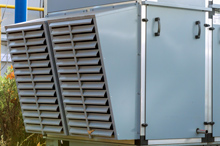 |
In the range of industrial sound traps marketed by ITS, acoustic louvers (with a dissipative filling i.e. rock, glass or polyester wool with an anti-defibration surfacing to absorb sound) are a good way to reduce the transmission of noise through openings (for technical rooms, noisy hardware sound enclosures, air handling units - CTA - both inlet and outlet) with limited space, and also offering protection against rain and against small animals entry. For more acoustic efficiency, a double arrangement of the sound absorbing elements - installed back-to-back, the whole forming a V) can be envisaged. |
|
Benefits
- excellent technical characteristics and robustness
- ease of implementation (easy assembly/disassembly)
- high adaptability of acoustic performance
- wide range of possible applications (in addition to fans noise reduction) such as on the occasion of the construction of enclosures and machines soundproofing housings, the construction of cabins, the ventilation of technical premises as well as of equipments for the production of electrical (resp. thermal or cooling) energy, or for the air admission of test rigs or acoustic testing rooms, the ventilation or air conditioning of buidlings ...
Presentation
- envelope generally rectangular (sometimes circular in case of silencer for air ducting works for example), metallic, single or double shell (perfect mechanical resistance over time) if required with an upstream connecting flange and with a downstream connecting flange and ( for some applications) with thermal, acoustic or thermoacoustic outer insulation
- splitters (sometimes called: baffles) generally parallelepipedic (except for silencers with a circular cross section), with metallic frames and structures
- thickness, filling (usually mineral wool: polyester wool or other for special applications), finishes, free open area, geometry of upstream and downstream ends: adapted depending on the desired performance
Construction
- in case of a sound trap with a rectangular cross section, the soundproofing device is in the form of a box-piece generally monobloc
Standard constitution (for rectangular cross section)
- casing made of galvanized sheet steel, thickness according to performance requirements, possibly with powder coating (other finishes on request) with connecting flanges upstream and downstream
- splitters (sometimes called: baffles) rectangular, with galvanized steel frames, with a profiled upper extremity for back pressure limitation
- filling made of medium density rock wool with a cover made of glass cloth or a glass fabric (in some cases)
- perforated facing made of galvanized steel sheet, thickness according to performance requirements (other finish upon request)
Options
- composition for special applications (e.g. clean rooms)
- splitters for dissipative silencer or reactive silencer: resonant silencer (with resonant plates / foils)
Anti-corrosion
- casing (when not made of stainless steeel):for typical applications, the ventilation silencers are protected by a multilayer coating system in accordance with ISO 12 944 C3 ; for more demanding applications, the ventilation silencers are protected by a multilayer coating system in accordance with ISO 12944 C4 or even C5 with high durability (above 15 years)
- splitters:for typical applications: metal parts with galvanisation;for more demanding applications: metal parts made of stainless steel
Weather resistance
- indoor or outdoor use in normal environments (other finish for different uses: on request)
Fire behavior (reaction to fire of ingredients according to standard NF F16-101)
- siding:galvanized finish: rating M0;powdercoating finish: rating M1
- filling:rock wool: rating M0;polyester: rating M1
Miscellaneous
- in case of a filling made of rock wool, a glass cloth prevents grinding
- in case of a filling made of polyester, no surface treatment is necessary, the filling being not subject to grinding (due to a surface microfusion) and being not in a position of releasing biopersistent material
- whatever the filling is, the ventilation silencers contain no element favorable to microbial growth
Acoustic and aeraulic performance
- measured according to ISO 7235 Acoustics - Laboratory measurement procedures for ducted silencers and air-terminal units - Insertion loss, flow noise and total pressure loss. Non standard performance can be obtained by the means of special constructions
- simulated (with results comparable to measurements) using Module 1 of the SILDIS® software developed and marketed by ITS[1]
Implementation
- on the occasion of the construction of industrial soundproofing equipment
Associated products and services (on request)
- structures/frames, delivery as a kit with assembly instructions (national and international). Complete study. On-site installation (national and international)
Other industrial sound traps marketed by ITS for applications with ambient temperature
Other industrial sound traps are marketed by ITS for applications with ambient temperature:
- for the air intake of large heat engines, compressors and combustion turbines (in many cases air filters provide additional noise attenuation e.g. at high frequencies)
- for air intake and discharge of cooling towers (baffles are often installed in concrete casings)
The operating principle of such noise attenuatos is the same as for the dissipative silencers of the Heating Ventilation Air Conditioning networks, mentioned above: the energy of the sound waves is reduced when passing between elements absorbing the sounds in a frequency range of more or less extent. However, the stakes are significantly higher:
- due to the acoustic power of the noise sources involved (which can be close to that of aircraft noise) and its desired reduction (it is not uncommon for a reduction of the order of 50 dB to be considered, this which is considerable)
- due to the allowable total pressure loss constraints (a few tens of Pascals offer little latitude for the sizing and design of silencers when the air flow is counted in hundreds of kilograms per second)
- due to the very large frontal surface to be considered (e.g. several hundred m2 for a class H gas turbine) making it essential to optimize, if only with regard to the financial aspect
The precise simulation of acoustic and aeraulic performance using Module 1 of the SILDIS® software developed and marketed by ITS[1] is often a key step in the process of developing soundproofing hardware in the context of such projects. The use of reliable commercial partners for the construction of such equipment, offering at the same time quality, respect of deadlines and an affordable price is what bases the competitiveness of the industrial sound traps offered by ITS in this very specific field of industrial acoustics.
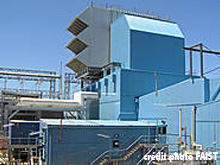
gas turbine air intake system (in grey on picture ; a filtration stage complement the sound trap needed for noise limitation) |
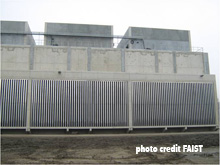
sound traps for intake (in lower part of picture ; airflow is horizontal) and for exhaust (in upper part of picture ; airflow is vertical) |
Industrial sound traps marketed by ITS for high temperature applications
The sound traps marketed by ITS for high temperature applications concern in particular:
- thermal engine exhausts (depending on the context: reactive, dissipative or combining the 2 soundproofing principles)
- gas turbines exhausts and chimneys of other combustion processes (in general: dissipative)
- venting of pressurized gas (most often combining upstream a perforated device, downstream a dissipative stage i.e. with a sound-absorbing material, which is at quasi-atomospheric pressure
Such sound traps are high-tech products, the sizing of which calls on sophisticated tools[2] to find the best possible compromise between acoustics and fluid mechanics, as far as performance is concerned (in addition to what has to do with the mechanical resistance, and that is not nothing for such devices installed outdoors, subject to very significant temperature gradients in addition to having to resist climatic and seismic risks and to having to last). Their construction calls for very specific know-how with regard in particular to the selection of raw materials, construction and assembly technologies, the qualification of welders, quality control, for customers whose level of requirement is in relation to the issues of all kinds encountered in the energy production sector.The offer of services of ITS in this area is diversified, taking into account the imperatives of each project, with resuts subject to a warranty.
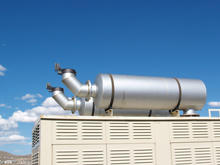
exhaust silencer for thermal engine (sound trap) |
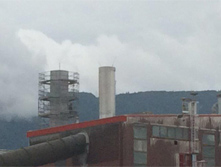
silencer (sound trap) for stack dowstream combustion process |
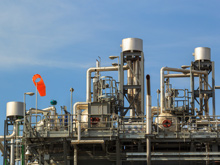
depressurization silencer (sound trap) |
Sound trap
|
Sorry, no dedicated brochure downloadable presently (however: available equipment) |
| See the frequently asked questions related to this equipment |
ITS offers industrial sound traps for soundproofing (noise reduction) e.g. for enclosures, machines canopies, buildings, air-conditionning networks, fans but also for engines, turbines cooling towers and pressurized fluids discharge to atmosphere.
Absorptive silencer, baffle silencer, dissipative silencer for ventilation / air conditioning systems, splitter silencer, ventilation silencer, sound trap: all equipment that one can source thanks to Isolation Technologie Services (ITS).